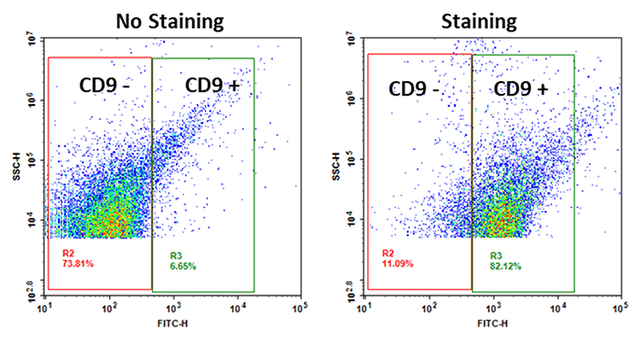ReadiPrep™ Exosome Isolation Kit
Example protocol
SAMPLE EXPERIMENTAL PROTOCOL
To ensure isolated exosomes originate from the cells, culture cells with exosome-depleted fetal bovine serum (FBS) or no FBS. Normal FBS contains a significantly higher amount of exosomes and may give false positive results. It is important to note that this kit has been tested only for exosome isolation from cell culture media.
Grow cells for a desired time period.
Harvest cell culture medium.
Centrifuge the cell culture medium at 2000 x g for 30 minutes to remove cell debris and remaining floating cells.
Transfer the supernatant into a new tube without disturbing the pellet.
Transfer the necessary volume of supernatant (prepared as described in "Preparation of cell samples") into a fresh tube, and then add an equal volume of Exosome Isolation Buffer. For instance, if you are isolating from 10 mL of cell culture medium, you should add 10 mL of Exosome Isolation Buffer.
Mix it well and incubate samples at 2 ℃ to 8 ℃ overnight.
After incubation, centrifuge the samples at 10,000 x g for 1 hour at 2 ℃ to 8 ℃.
Remove the supernatant and discard it. Exosomes should be in the pellet at the bottom of the tube.
Note: The pellet may not be visible in most cases.
Resuspend the pellet in 1X PBS with the desired volume. For example, if the starting cell culture media volume is 10 mL, then the resuspension volume should be 100 µL–1 mL.
Store the isolated exosomes at 2 ℃ to 8 ℃ for up to 1 week or at ≤ 20 °C for long-term storage.
References
Authors: Ansari, Farshid Jaberi and Tafti, Hossein Ahmadi and Amanzadeh, Amir and Rabbani, Shahram and Shokrgozar, Mohammad Ali and Heidari, Reza and Behroozi, Javad and Eyni, Hossein and Uversky, Vladimir N and Ghanbari, Hossein
Journal: Biochemistry and biophysics reports (2024): 101668
Authors: Teflischi Gharavi, Abdulwahab and Niknejad, Azadeh and Irian, Saeed and Rahimi, Amirabbas and Salimi, Rahimi
Journal: Iranian biomedical journal (2024)
Authors: Kim, Minse and Song, Chi-Yeon and Lee, Jin Sil and Ahn, Yu-Rim and Choi, Jaewon and Lee, Sang Hoon and Shin, SoJin and Na, Hee Jun and Kim, Hyun-Ouk
Journal: Advanced healthcare materials (2024): e2303782
Authors: Gorgzadeh, Amirsasan and Nazari, Ahmad and Ali Ehsan Ismaeel, Adnan and Safarzadeh, Diba and Hassan, Jawad A K and Mohammadzadehsaliani, Saman and Kheradjoo, Hadis and Yasamineh, Pooneh and Yasamineh, Saman
Journal: Virology journal (2024): 34
Authors: Chen, Haolin and Qi, Yu and Yang, Chenyu and Tai, Qunfei and Zhang, Man and Shen, Xi-Zhong and Deng, Chunhui and Guo, Jianming and Jiang, Shuai and Sun, Nianrong
Journal: ACS nano (2023): 23924-23935


